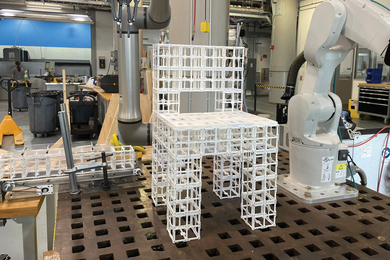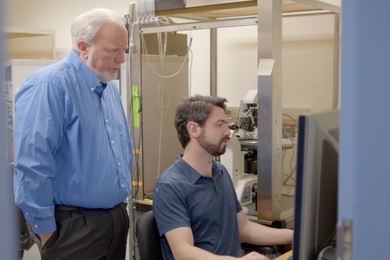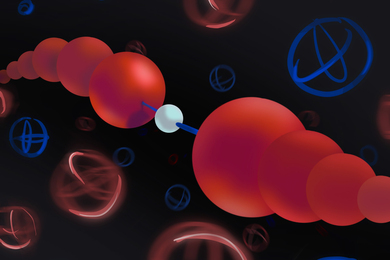Researchers analyzing global data from a high energy physics experiment that flew on NASA's Space Shuttle a year ago have found intriguing information about cosmic rays and how they interact with the Earth's magnetic field.
The sophisticated cosmic ray detector, known as the Alpha Magnetic Spectrometer (AMS), flew in the STS-91 shuttle payload bay for 10 days in June 1998 and gathered about 100 hours of data. The AMS recorded the tracks of millions of cosmic ray particles, the debris released by explosions in distant stars. In one experiment, AMS collected a large amount of global-wide orbital data. The data provide a far more comprehensive and accurate description of the global distribution and movement of cosmic rays than available previously.
The particle tracks recorded by AMS showed how different cosmic particles respond to the Earth's magnetic field. In orbit, AMS was able to scan cosmic rays arriving at different latitudes. Researchers expected the magnetic field to repel less energetic particles arriving around the equator. This terrestrial magnetic field repulsion becomes weaker at higher latitudes, so researchers expected to see more particles of lower energy nearer the North and South Poles.
Instead, AMS found high levels of lower energy protons at almost all latitudes, particularly over the equator. For protons below six billion electron volts in a 4,000 kilometer arc over the equator at an altitude of 400 kilometers, the AMS counted as many particles moving upwards (away from Earth) as moving downwards. Researchers saw a similar effect with cosmic electrons having energies of about three billion electron volts.
These electrons and their antiparticles known as positrons are continuously produced by collisions among other high-energy cosmic particles. Scientists expect that equal numbers of electrons and positrons should be produced. However, at the equator, AMS saw in the billion electron volt region about four times as many positrons as electrons.
Nobel Laureate and M.I.T. professor Samuel Ting, head of the AMS international collaboration, reported the results at the recent Inner Space/Outer Space Symposiumat the Department of Energy's Fermi National Accelerator Laboratory in Batavia, Illinois.
The AMS is the first large magnet experiment ever placed in Earth's orbit. AMS's instrumentation allowed researchers to measure higher energy particles with greater accuracy than previously possible. The particles AMS searched for cannot be detected on the ground because they are absorbed by Earth's atmosphere, so the detector must be deployed in space. The charge of such particles can be identified only by their trajectories in a magnetic field.
Over the years, important experiments from balloons at upper layers of the atmosphere (40 kilometers from Earth) and small-scale experiments from satellites have shown that when cosmic rays enter Earth's atmosphere they produce secondary particles in all directions. Some of these particles are trapped in the Earth's magnetic field. However, the AMS experiment was done far away from Earth and measured particles at higher energies. It is not clear how to use the existing knowledge to explain AMS data accurately.
Researchers designed the AMS detector to search for both antimatter and "dark matter" to answer two specific questions: First, if equal amounts of matter and antimatter were produced at the beginning of the universe as described by the Big Bang scenario, and the galaxies we now see are made only of matter, where has the antimatter gone? Second, since the mass of a galaxy seems to be greater than the visible mass of all its stars, gas and dust, is there dark matter of a new kind that has eluded discovery?
AMS saw no primordial antimatter during the 10-day Shuttle flight. Of the nearly three million cosmic helium nuclei detected arriving from outer space, the AMS found no anti-helium nuclei. When NASA installs AMS on the International Space Station in about 2003 to gather data for about three years, scientists will conduct a much more extensive search for antimatter and dark matter.
As part of its long-standing role in high energy physics research, the U.S. Department of Energy is supporting the scientific leadership and part of the funding for the AMS. The AMS project is an international scientific collaboration that includes 37 research institutions in China, Finland, France, Germany, Italy, Portugal, Romania, Russia, Spain, Switzerland, Taiwan, Korea and the United States. Additional information on AMS is available on the Internet at http://www-lns.mit.edu.





